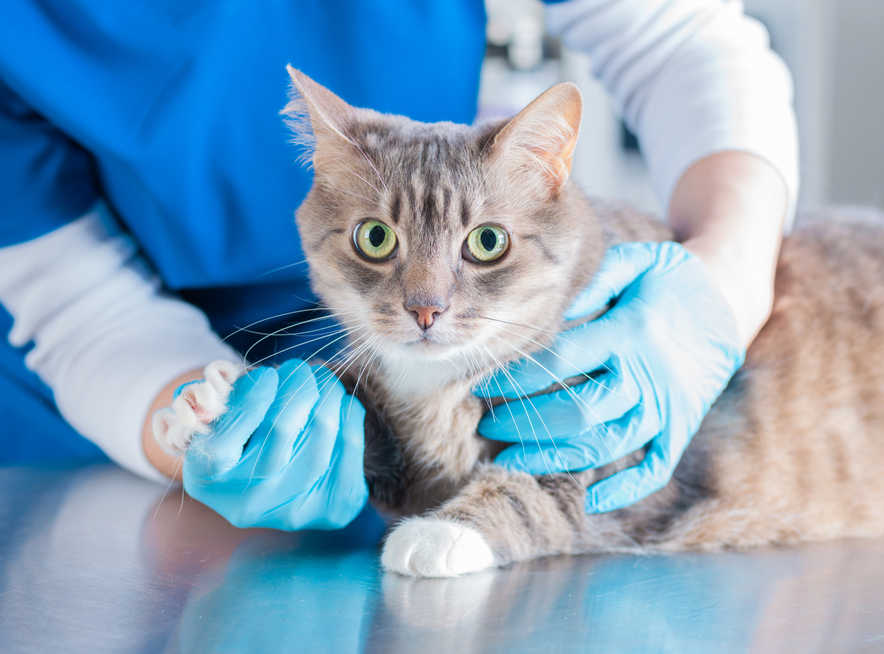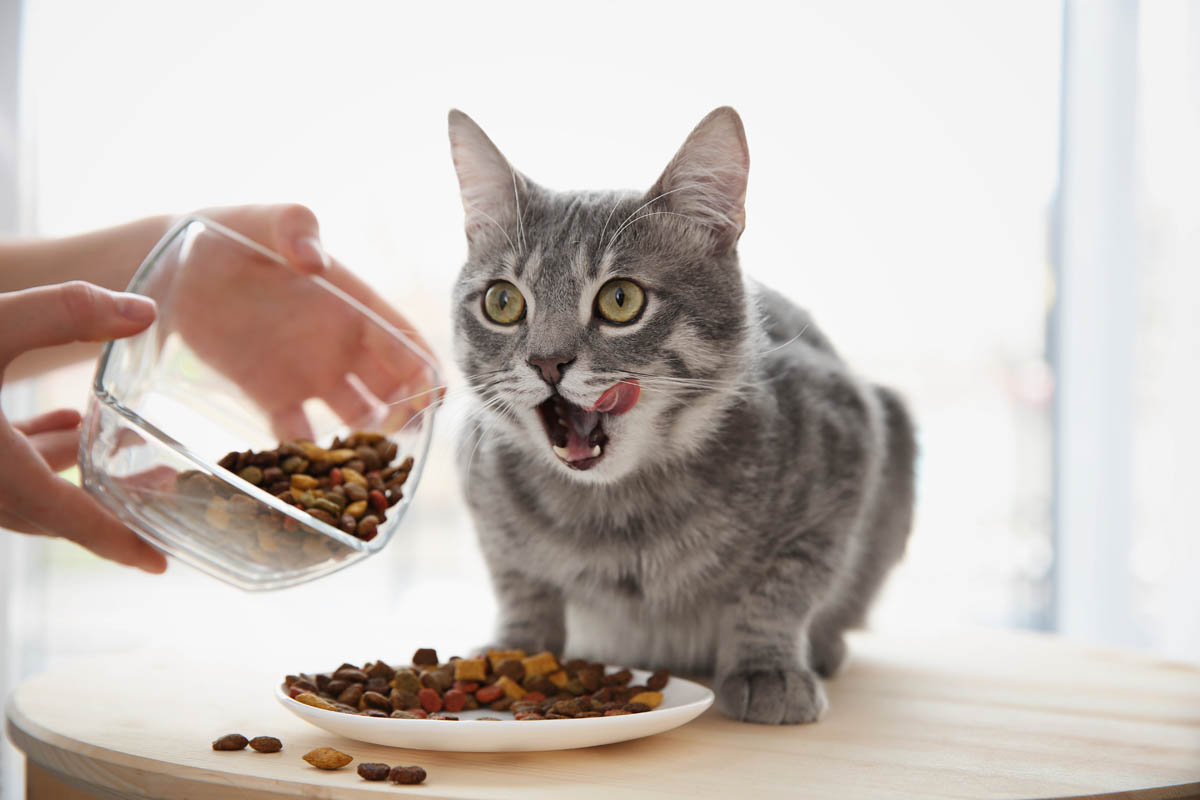Some cats thrive on a low energy physical state. Others are extremely active-day and night. No matter what the normal activity level of your cat, any decrease in their normal can be considered low energy, otherwise known as lethargy. Low energy every once in awhile is usually not a cause for concern, but if those off-days become more frequent or presistent, it’s time to seek veterinary care. This is even true if your cat still has a normal appetite and everything else seems fine.
Most likely causes of low energy in cats (when your cat is still eating well)
Lethargy in cats can stem from a variety of causes, and the lethargy itself isn’t a firm diagnosis of anything. The only way to really get to the bottom of the issue is to seek veterinary care and follow your cat’s vet’s recommendations for testing and treatment. Some possible causes of lethargy or low energy can include:
1) Stress: Changes in behavior, including low energy or lethargy, may point to stress. Because cats have their own internal emotional experiences and can’t verbally express their worries or concerns, it can be difficult to determine what the stressor is. When a new or scary human/ animal, place, experience, sound, or even smell is introduced to them, their fear may manifest in reclusiveness and hiding. Generally not severe, stress-related lethargy can be managed by identifying and modifying the stressor, or making environmental changes to help the cat feel more comfortable in their surroundings.
2) Infections: Lethargy, along with other signs, may point to infection. These signs may include things like changes to appetite, vomiting/ diarrhea, urinary issues, bothering at a particular area of the body, or presence of a fever. Infections can include viral or fungal infections, as well as bacterial infections in the ear or skin, teeth, bladder, or even infections internally that can’t be detected without veterinary imaging studies or laboratory tests. Severity varies depending on the type and location of infection. For example, a minor ear infection might cause lethargy in a sensitive cat, but is usually easily treated and quickly resolved. Other types of infection though, require professional testing by a veterinarian, and often need prescription antibiotics, antivirals, or antifungals for successful treatment
3) Pain: Cats are extremely (and frustratingly) good at masking their pain and unless it is excruciating, most cat’s won’t overtly express that something is wrong. Instead, they may only appear slightly lethargic. They may also become reclusive and start avoiding normal interactions. Lethargy stemming from pain can range from moderate to severe, and diagnosis typically involves physical examinations and imaging, and possibly laboratory tests too. While the signs of pain in cats may seem subtle at first, many owners report that their cat who is lethargic from pain becomes “a different cat” once appropriate prescription pain management is started.
4) Anemia: One of the more rare, but unfortunately more serious, potential causes of lethargy is a less than normal amount of red blood cells or hemoglobin in the body, called anemia. For owners, it’s most easily recognized by pale gums and tongue. Anemia is a potentially deadly condition that can worsen quickly, and needs prompt veterinary attention for a successful outcome.
5) Thyroid issues: Thyroid disease, most commonly hyperthyroidism in cats, is recognized as the most common endocrine disease in cats, affecting on average at least 10% of cats over the age of 10. The earliest signs of thyroid disease in a cat may include lethargy and weight loss despite a healthy appetite. A veterinarian can diagnose these issues through blood tests, and treatment depends on the specific thyroid condition identified, and the doctor’s recommendation. There are a variety of treatment options but all require veterinary intervention. Treatment options may include medication, radioactive iodine therapy, thyroidectomy (removal of the thyroid), or use of a specialized diet.
6) Internal organ problems: Cats are particularly prone to kidney disease, characterized by the kidney’s inability to filter waste products out of blood the way they should. Cats can also develop pancreatitis, where the pancreas becomes inflamed, often for unknown reasons. Liver disease may also start presenting as lethargy, before it advances into liver failure. Even heart disease can start out looking like a simple case of lethargy, since we as cat owners aren’t routinely listening to our cats heart and lungs, and since their lifestyles are often pretty sedentary.
Any cat who appears to have lethargy or low energy should be scheduled for a visit with their veterinarian as early as is convenient. If they have any signs in addition to lethargy (pale, yellow, urinary issues, vomiting or diarrhea, signs of pain, etc) an urgent or emergency veterinary visit should be pursued as soon as possible.
Signs to monitor
Lethargy may appear to be the only sign, but even subtle changes in these other signs could indicate a greater issue that needs quick intervention:
- Appetite: Any change in appetite, whether dramatic or subtle, is an indicator that something more serious is going on. If your cat is lethargic and also skips a meal, or even if they seem to only eat part of their normal full meal, it is concerning and should be investigated by a veterinary care team.
- Litter box habits: Increases or decreases in urine or bowel movement frequency or volume are concerning when paired with low energy, as the combination of signs can point to a variety of health concerns.
- Activity and interaction: Reduced interest in play and exploration may be a sign of lethargy, as is reclusiveness in a cat who is otherwise social. You may notice the cat who usually sleeps in the living room has chosen a spot under the bed instead; you could see the opposite too. A cat who typically self-isolates may suddenly seem unusually gregarious. This could be attention-seeking as a way for your cat to communicate something’s not quite right.
What to do when my cat has low energy but is eating well?
When your cat experiences low energy or lethargy alongside a good appetite, you may be tempted to brush off the abnormality assuming that a good appetite proves there isn’t a problem. While monitoring for a day or even two may be reasonable, lethargy that lasts for more than this is concerning. Even if the appetite remains normal, lethargy accompanied by any other signs should be looked into promptly. While you wait to decide whether or not to go to the vet, keep an eye on these parameters for any changes:
- Create a timeline: Make a note on your phone or calendar about when you first noticed your cat’s lethargy. Days go by quickly and your cat may have been experiencing lethargy longer than you thought. Note any other signs as well.
- Looking over your cat, head-to-toe: While not as comprehensive as a veterinarian’s examination, it’s worthwhile for you to check your cat over for any visible signs of injury, discomfort, or other abnormalities. Be sure to note these too, so you can share the information with your cat’s veterinarian.
- Litter box examination: Think about your cat’s typical litter box habits and note anything out of the ordinary – greater or fewer numbers of urine or bowel movement clumps in the litter, smaller amounts of urine or stool at a time, having to clean out the litter box more or less often. Even color or consistency changes in both urine and bowel movements can point to an issue. If you notice any of these, be sure to bring a fresh fecal sample to the vet visit. If you want to collect urine, give your cat an empty litter box instead of their usual litter and if they deposit a sample, bring that in. In general though, if you suspect a urinary issue it’s best to pull the litter box in the few hours leading up to an appointment so your cat has a full bladder and the vet can get a sample directly from the bladder.
- Consult your veterinarian: If the lethargy lasts more than a day or two, if it becomes worse, or if it is accompanied by ANY other abnormal signs, make an appointment with your cat’s veterinarian as soon as possible.
When to seek veterinary assistance

While home monitoring is a great first step, if low energy or lethargy are accompanied by any of these signs, you need to make a vet appointment immediately:
- Vomiting or diarrhea: If your cat is lethargic, and they’ve had vomiting or diarrhea multiple times for more than a couple of hours, get your cat in for the soonest available appointment
- Refusing food: If your cat is lethargic, and they’ve refused food for more than 24 hours (or have been eating less food than usual for a day or more), get an appointment as soon as possible. Cats who aren’t eating can rapidly develop a deadly condition called hepatic lipidosis that affects their liver, and a can be difficult to treat.
- Struggling to urinate: Any difficulty passing urine is an emergency, especially if accompanied by lethargy. Cats can develop a urinary obstruction, which means urine can’t leave the body and it can rapidly cause kidney and other organ failure. Struggling to urinate may also appear to be constipation, so a constipated cat should also be brought in for care immediately, especially if the cat is also lethargic
- Breathing issues: Any labored breathing is a serious concern, especially if the cat is also lethargic. Trouble breathing can present as faster breathing patterns, coughing/ gagging, raspy breathing sounds, or even gasping for breath. None of these signs have to be constant; even a single episode of breathing trouble should be investigated. It may be an indicator of feline asthma, an allergy to something airborne, or something more sinister like heart disease.
Frequently Asked Questions
Is it normal for older cats to have reduced energy levels?
While some aging cats may naturally slow down, even cats in advanced age aren’t “normally” lethargic. Sleeping more often can be normal, refusal to participate in normal daily activities like grooming, interacting, or walking around are not normal. Even in older cats, low energy usually points to a possibly treatable health condition like thyroid or kidney disease, an infection, or some other health condition.
Never assume that low energy is because a cat is “old”. Always seek veterinary care for a cat who is lethargic.
Should I be concerned if my cat’s appetite changes?
Alterations in appetite are never normal and can signify underlying health problems. Changes to appetite should not be ignored.
How can I monitor my cat’s food and water intake?
Monitoring food and water intake is a great way to detect some problems early on. Here are some tips for keeping track of normal versus abnormal eating and drinking habits:
- Quantify all meals offered, so you know how much you’re giving your cat, and so you know how much or how little they’re consuming. Knowing how much food you give on a predictable schedule makes it much easier to notice when a cat skips a meal or only eats half or less of the amount offered.
- Measure how much water fits in your cat’s dish, and keep track of how often you have to fill it. This may be more difficult in a house with multiple cats or a mix of cats and dogs who share water dishes. In that case, just try to be aware of how often your cat is visiting the water dish and how long they stay there drinking. If you suspect they’re drinking more or less than usual, consider secluding them away from other animals for 1 – 2 days and measuring water intake.
- Consider using automated feeders that give out specific portions, so your cat is fed predictable amounts on a predictable schedule, giving you a chance to assess if they’re skipping meals or leaving food behind.
How can I prevent low energy issues in my cat?
Prevention involves providing appropriate healthcare and keeping a close eye on your cat. You don’t have to keep a journal of all of your cat’s behaviors or routines, but awareness is key.
- Keep up on veterinarian- provided preventative healthcare. This includes routine vaccinations, medications to prevent or treat disease, and regular check-ups that may include lab tests.
- Schedule regular veterinary check-ups to catch issues early. Visits with a veterinarian should happen at least once a year in healthy young or adult cats, and twice a year in older cats or cats with health conditions. Changes to the physical exam or to routine lab tests might catch an issue before it progresses to the point where your cat feels ill and appears to have low energy.
- Provide a balanced and appropriate diet for your cat’s life stage. Most commercially available cat foods can be sufficient to maintain a cat’s health but if you have questions about the right diet for your cat, consult with your cat’s veterinarian.


